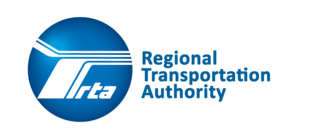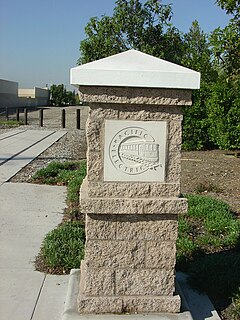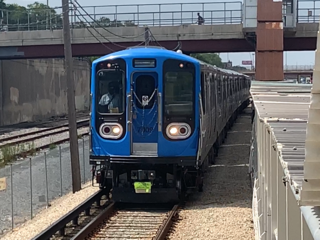
The Los Angeles County Metropolitan Transportation Authority (LACMTA), commonly branded as Metro, is the agency that plans, operates, and coordinates funding for most of the transportation system in Los Angeles County. The agency directly operates a large transit system that includes bus, light rail, heavy rail (subway), and bus rapid transit services; and provides funding for transit it does not operate, including Metrolink commuter rail, municipal bus operators and paratransit services. Metro also provides funding and directs planning for railroad and highway projects within Los Angeles County. In 2021, the system had a ridership of 227,718,700, or about per weekday as of the fourth quarter of 2021.

The Chicago "L" is the rapid transit system serving the city of Chicago and some of its surrounding suburbs in the U.S. state of Illinois. Operated by the Chicago Transit Authority (CTA), it is the fourth-largest rapid transit system in the United States in terms of total route length, at 102.8 miles (165.4 km) long as of 2014, and the third-busiest rail mass transit system in the United States, after the New York City Subway and the Washington Metro. In 2016, the "L" had 1,492 rail cars, eight different routes, and 145 train stations. In 2021, the system had 78,623,200 rides, or about 294,000 per weekday in the fourth quarter of 2021.

The Chicago Transit Authority (CTA) is the operator of mass transit in Chicago, Illinois, United States, and some of its surrounding suburbs, including the trains of the Chicago 'L' and CTA bus service. In 2021, the system had a ridership of 195,980,600, or about 714,700 per weekday as of the fourth quarter of 2021.

The Yellow Line, alternatively known as the Skokie Swift, is a branch of the Chicago "L" in Chicago, Illinois. The 4.7-mile (7.6 km) route runs from the Howard Terminal on the north side of Chicago, through the southern part of Evanston and to the Dempster Terminal in Skokie, Illinois making one intermediate stop at Oakton Street in Skokie.

The Purple Line of the Chicago "L" is a 3.9-mile (6.3 km) route on the northernmost section of the system. Normally, it extends south from Linden in Wilmette, passing through Evanston to Howard, on Chicago's North Side. In 2019, the average weekday boardings on the Purple Line was 9,594. It is the shortest route in the CTA rail system except during weekday peaks and rush hours.

The San Joaquins is a passenger train service operated by Amtrak in California's San Joaquin Valley. Seven daily round trips run between its southern terminus at Bakersfield and Stockton, where the route splits to Oakland or Sacramento.

Amtrak California is a brand name used by the California Department of Transportation (Caltrans) Division of Rail for three state-supported Amtrak commuter rail routes in California – the Capitol Corridor, the Pacific Surfliner, and the San Joaquins – and their associated connecting network of Thruway Motorcoach buses.

The Intermodal Surface Transportation Efficiency Act of 1991 is a United States federal law that posed a major change to transportation planning and policy, as the first U.S. federal legislation on the subject in the post-Interstate Highway System era.

The Regional Transportation Authority (RTA) is the financial and oversight body for the three transit agencies in northeastern Illinois; the Chicago Transit Authority (CTA), Metra, and Pace, which are called Service Boards in the RTA Act. RTA serves Cook, DuPage, Kane, Lake, McHenry and Will counties.

Plans for high-speed rail in the United States date back to the High-Speed Ground Transportation Act of 1965. Various state and federal proposals have followed. Despite being one of the world's first countries to get high-speed trains, it failed to spread. Definitions of what constitutes high-speed rail vary, including a range of speeds over 110 mph (180 km/h) and dedicated rail lines. Inter-city rail with top speeds between 90 and 125 mph is sometimes referred to in the United States as higher-speed rail.

HNTB Corporation is an American infrastructure design firm that was founded in 1914. The firm has numerous offices across the United States, and has designed many sports facilities, airports, bridges, tunnels, roadways, and rail and transit systems across the United States and around the world.
TYLin is a global, multi-disciplinary infrastructure services firm. Headquartered in San Francisco, TYLin established its business in the design of long-span bridges and specialty structures.

California's transportation system is complex and dynamic. Although known for its car culture and extensive network of freeways and roads, the state also has a vast array of rail, sea, and air transport. Several subway, light rail, and commuter rail networks are found in many of the state's largest population centers. In addition, with the state's location on the West Coast of the United States, several important ports in California handle freight shipments from the Pacific Rim and beyond. A number of airports are also spread out across the state, ranging from small general aviation airports to large international hubs like Los Angeles International Airport and San Francisco International Airport.

Proposition 1A is a law that was approved by California voters in the November 2008 state elections. It was a ballot proposition and bond measure that allocated funds for the California High-Speed Rail Authority. It is now contained within Chapter 20 of Division 3 of the California Streets and Highways Code.

Morgan is an 'L' station on the CTA's Green and Pink Lines in the Near West Side neighborhood of Chicago, Illinois. The original station on this site was closed and demolished in early 1949; after years of intense lobbying by local residents and members of the Fulton Market Merchant Association, the Chicago Department of Transportation rebuilt the station from 2010–2012. The new station opened on May 18, 2012.

Chicago, Illinois is the third-largest city in the United States and a major transportation hub for the Midwest. The city is served by two major airports, and is the main freight rail hub of North America.

The West Santa Ana Branch is a rail right-of-way formerly used by the Pacific Electric's (PE) Santa Ana route in Los Angeles County and Orange County in Southern California. The Los Angeles County Metropolitan Transportation Authority (Metro) owns the segment of the right-of-way in Los Angeles County, and the Orange County Transportation Authority (OCTA) owns the segment in Orange County.
In the spring of 2012, Chicago Transit Authority started a station and track rehabilitation program dubbed "Red Ahead", beginning on the North Side Main Line, which is called the "Red North" project. The program monitors the full route of the Red Line, which does not include the stations of Loyola, Bryn Mawr, Sheridan, or Wilson. Stations between Wilson through Fullerton, and the State Street subway, are also not included. In May 2012, the CTA started to work on the North Side Main Line stations which includes Jarvis, Morse, Granville, Thorndale, Berwyn, Argyle, and Lawrence. The stations are listed in order, starting at Granville, then Morse, Thorndale, Argyle, Berwyn, Lawrence, and finally Jarvis. This project started in June 2012 and completed in December 2012. This project is also part of the Red Ahead's "Red & Purple Modernization" project.

The San Bernardino Transit Center is an intermodal transit center in downtown San Bernardino, California, United States. It is owned and operated by Omnitrans, the area's public transportation agency.

The 7000-series is a series of rail car for the Chicago "L". The base order is for 400 cars and will be used to replace the 2600-series cars, dating back to the 1980s, which are currently assigned to the Blue, Brown, and Orange Lines. If the Chicago Transit Authority (CTA) ordered the additional 446 cars, these cars would replace the 3200-series cars, dating back to the early 1990s, which are currently assigned to the Blue and Brown Lines. Including all options, which is a total of 846 cars, the order will cost $1.3 billion.


















